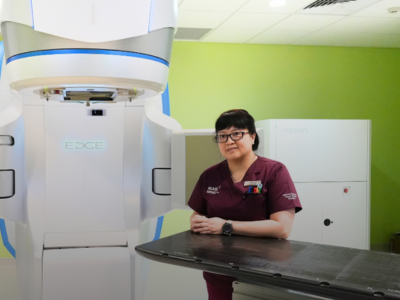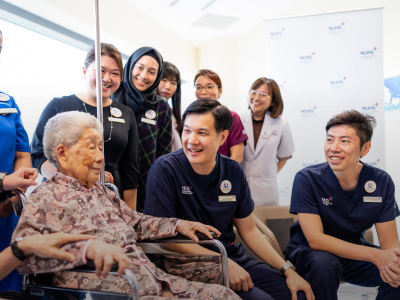Behind the beam: The radiation physicists shaping your cancer care
PUBLISHED ON
SCROLL DOWN
Every day, dozens of patients at the National University Cancer Institute, Singapore (NCIS) receive high doses of radiation aimed at shrinking the tumours and cancer cells attacking their bodies.
What many may not realise is that behind the scenes, allied health professionals like Mr Khor Jong Shin work tirelessly to make sure the machines that deliver this life-saving treatment are properly calibrated.
As a Senior Radiation Physicist at NCIS’s Department of Radiation Oncology, Mr Khor oversees complex machines like linear accelerators, which deliver precise beams of radiation to cancerous cells.
His role involves reviewing key details such as the consistency of the radiation dose, radiation beam alignment, safety features and mechanical components. His day ends with painstaking machine checks, as he performs patient-specific quality assurance (QA) tests using highly specialised tools to confirm everything is in order.
“This involves delivering the treatment plan on a measuring device for advanced treatments like stereotactic radiosurgery – a precise form of radiation therapy for small brain tumours – and stereotactic body radiation therapy, which targets tumours in the body with high precision,” explained Mr Khor. If the machines fail the passing criteria, he works with dosimetrists on the treatment plan before it is administered to patients.
Starting out in diagnostic imaging and nuclear medicine, he realised after two years that his interest lay in medical physics. “I thought it might be something interesting where I could apply physics principles in the medical field and improve people’s lives,” said Mr Khor, who holds a master’s degree in medical physics from the University of Malaya.
The safety and accuracy of the machines are maintained through a strict schedule of calibration and QA checks – performed daily, bimonthly and annually – alongside rigorous radiation safety protocols. “If any issues are detected during the QA process, we may calibrate or coordinate with service engineers for immediate repairs to keep the machines ready for treatment the next day,” said Mr Khor. Maintaining the precision of these machines is just one of many scientific and technical tasks that radiation physicists handle every day.
Mr Khor works closely with oncologists, dosimetrists – who calculate the precise radiation doses – and radiation therapists, who administer the treatment, to fine-tune treatment plans that demand pinpoint accuracy.
He also oversees complex systems like the brachytherapy afterloader, which delivers a high dose of radiation directly to the tumour, and the computed tomography (CT) scanner, which uses X-rays to produce detailed images that are essential for treatment planning.
All of this is powered by the treatment planning system – software that simulates the distribution of radiation doses to create precise treatment plans.
“Additionally, we implement strict radiation safety protocols to protect patients and staff by monitoring exposure levels and keeping safety standards up to date,” Mr Khor added.
One of the more challenging treatments that Mr Khor manages is brachytherapy, especially when it is used to target areas like the prostate. The procedure can take several hours, from catheter insertion to treatment.
More than 16 thin catheters are placed close together to guide the radioactive source precisely to the tumour and deliver the correct dose of radiation. “We need to ensure the catheter’s travel path is unblocked, so that the radioactive source does not get stuck while travelling in and out,” said Mr Khor.
CT images help show where catheters are in relation to the patient's body, but each catheter needs to be identified on its own because they can overlap in the images. It is important to connect them to the right channels to avoid delivering radiation to the wrong area.
Although much of his work takes place behind the scenes, Mr Khor occasionally interacts directly with patients, particularly during a highly specialised procedure known as total body irradiation.
This treatment is often part of the preparation for bone marrow or stem cell transplants, where the entire body – with its varying density and thickness – needs to receive an even dose of radiation. Measuring devices are placed directly on the patient to verify that the radiation dose is delivered correctly.
“Knowing that my work ensures treatments are delivered safely and accurately gives me a sense of satisfaction.”
– Mr Khor Jong Shin
While Mr Khor and his colleagues are typically called radiation physicists, he noted that the correct term is “medical physicist” – a practitioner of medical physics. Although classified as allied health professionals, they focus more on scientific and technical work, such as equipment calibration and safety protocols, rather than direct patient care.
“This may also be characterised by the true importance of our work, which is to holistically apply scientific principles to ensure patients receive the correct therapy and imaging,” he said.
To stay up to date with the newest innovations, Mr Khor often participates in continuing education programmes like online webinars, attends conferences, and regularly reviews scientific literature.
“I am motivated by the opportunity to apply the principles of physics and cutting-edge technology to directly improve accuracy, precision and safety in all aspects of radiation therapy,” he said.
Interested to join us as a Radiation Physicist? Find out more about working in our institutions and the work that they do here.
In consultation with Mr Khor Jong Shin, Senior Radiation Physicist, Department of Radiation Oncology, NCIS.


